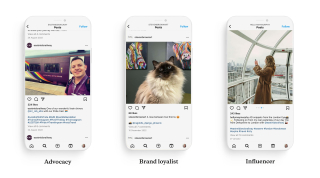
Written by Grace Parkin
Struggling to fill your brand content calendar? What if we told you there is a treasure trove of content waiting to be dutifully mined? That is, a wealth of fantastic user-generated content (UGC) ready and waiting to be tapped into.
What is user-generated content (UGC)?
In short, UGC is content that’s original and published on social media or other channels. It could be images, video, reviews, testimonials or even a podcast. While brand-specific content is the gold standard, using interest-focused UGC is a great starting point.
One of our clients, Coach Hire Comparison, is no stranger to user-generated content. Initially CHC’s content calendar was filled with inauthentic stock imagery that came at a cost. Later though, we pivoted to sourcing brilliant travel photography from across the UK via Instagram. While we couldn’t find specific ‘coach’ pictures, we could showcase some of the great locations people could visit across the UK in a coach.
Where does user-generated content come from?
There’s lots of places you can source user-generated content from.
For brand-specific content, you’re best to tap into your existing customer base and brand loyalists. This should be as easy as monitoring your @mentions and brand hashtags. Sometimes, they’ll even send them directly to you via your messages.
If you’re looking to create advocacy-type content, then you’ve likely got a ready-made social base in the form of your employees. Seek out the gregarious-types to film behind-the-scenes and tap into trending content.
Some user-generated content can be sourced from social media influencers. Although it’ll likely come at a cost, you can reach a whole different and ready-made audience by sharing their content.
Lastly, you can source user-generated content of specific interests by searching hashtags on Instagram. For example, #UKPhotography #TravelPhotography.
Why is it important?
Ultimately, people trust other people. It’s essential to think of user-generated content as the modern-day word of mouth.
According to Stackla Survey, consumers are 2.4 times more likely to view user-generated content as authentic compared to content created by brands.

Here’s a few reasons why we think UGC forms an essential part of any social media marketing strategy:
1. Diverse and creative content
Creative content is one of the primary drivers for any social media campaign to be successful. When creating all of the content in-house, it can limit the diversity and creativity of the content. But, there’s a whole world of creative thoughts and perspectives out there, you only need to find them to take your social media content to the next level.
2. Highlight social-proof
In a digital-age of ever-more savvy consumers, it’s important for brands to present user-generated content to build social proof. After all, self-promotion is not what consumers trust, your customers are.
3. Showcase brand advocacy
When your customers believe in you, others will too. If your brand has loyal customers, you can use their created content to showcase brand advocacy that will help in attracting new customers.
4. Constant flow of content (for those who seek it out)
As social media specialists, we’re constantly seeking out and creating new social content for our clients. However, utilising user-generated content can provide you with a continuous stream of authentic content for your feeds.
5. Community building
In the end, good social media is all about having a back-and-forth conversation, and, ideally, building a community. Be it small or large, using your loyal customers’ content can help to build an online community.
Here at Fluid, we’re constantly seeking out and reaching out to people to build a library of user-generated content for our clients. If you’re in charge of social media for your business, remember to not neglect this all-important content source when planning your content calendars.







